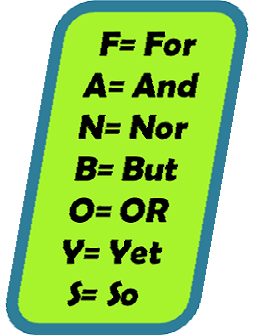Conjunction is a word that connects or joins clauses, words, phrases together in a sentence. Conjunctions are used to coordinate words in a sentence. “but”, “although”, “while” are some common conjunctions. Three types of conjunctions are Coordinating Conjunctions, Subordinating Conjunctions, Correlative Conjunctions. Let us learn the types and examples of conjunctions and their correct use.
Suggested Videos
Conjunction Definition
Conjunctions are very important words used in English. You use them every day! A Conjunction is a word that joins parts of a sentence, phrases or other words together. Conjunctions are used as single words or in pairs. Example: and, but, or are used by themselves, whereas, neither/nor, either/or are conjunction pairs.
Browse more Topics Under Conjunction
- Coordinating Conjunction
- Paired or Correlative and Compound Conjunctions
- Subordinating Conjunction
- Use of Conjunctions
Types of Conjunctions
- Coordinating conjunctions– are single words that join similar words or phrases or elements.
- Subordinating conjunctions– also join similar words, phrases or elements but exist in pairs.
- Correlative conjunctions- They are actually adverbs that are used as conjunctions.
Learn more about types of conjunctions here in detail.
Examples of Conjunctions: FANBOYS
Let us now understand the use of different conjunctions that we routinely use in our day-to-day communication.
- For- It is used to sight a reason or purpose. Example: I bought a new bag for my upcoming trip.
- And- It connects or adds one thing to another. Example: I love both apples and bananas.
- Nor- It is used to indicate a negative idea to an already existing negative idea. Example: Neither the white dress nor the yellow one looks good on me.
- But- It is used to show a contrast between two items or ideas. Example: I wanted to go for a hike but I have to go to work today.
- Or- It is used to present an alternative to an already present positive idea. Example: Would you like tea or coffee?
- Yet- It is used to introduce an idea that adds something to a previous idea and is usually contrasting with it. Example: I practice daily yet I couldn’t put up a good show yesterday.
- So- It is a conjunction that is used to indicate the effect or result of an occurrence. Example: Both parents worked hard so that their children could study in good schools.
All the above are coordinating conjunctions and are easy to remember using the pneumonic: ‘FANBOYS‘. Coordinating conjunctions never come at the beginning of a sentence.
 (Source: partofspeech)
(Source: partofspeech)
Some conjunctions, like the subordinating conjunctions, can come at the beginning of the sentence as well. They introduce a dependent clause and join it to an independent clause. Examples of this type of conjunction: As, because, if, till, since, and when. Few sentences that show the use of the above-mentioned conjunctions are:
- It is because of my parents that I can stand on my feet today.
- Life has not been the same since I fell for you.
- I’m sure of getting good grades because I study every day.
The third type of conjunctions i.e correlative conjunctions, as mentioned earlier in the chapter, are those which occur in pairs. They need to be used in the same sentence at different parts to make sense out of the sentence. Examples of these types of conjunction are: Either: or, neither: nor, both: and, not only: but also, not: but etc.
Few sentences that show the uses of the above-mentioned conjunctions are:
- You can either have the cheesecake or the frozen hot chocolate.
- She said she neither wanted the yogurt nor the ice cream.
- I am in the mood for not ice cream but for some waffles.
Solved Questions for You
Q: Meera does not like to swim, ____ she does enjoy cycling.
A. and B. or
C. but D. nor
Sol. (c) But
The sentence talks about Meera who doesn’t like to swim. Meera enjoys cycling. Since the two ideas are contrasting, we use the conjunction ‘but’ and so option C) is the correct answer.
Q: Identify the conjunction in the following sentence: Practice regularly, otherwise, you will not become a great pianist.
- you
- will
- otherwise
- become
Ans: The correct answer is Option C. We are to identify the conjunction in the given sentence. A conjunction is a word that is used to connect clauses or sentences or to coordinate words in the same clause (e.g. and, but, if). In the given sentence ‘otherwise’ is the conjunction that joins two sentences i.e. practice regularly and you will not become a great pianist. The remaining options are incorrect because:
A) – YOU is a pronoun
B) – WILL is used to indicate future tense.
D) – BECOME is a verb






What is appropriate conjunction
kindly help put in the right conjunction in the following sentences. thanks.
1. newton was busy. He did not notice the food on the table. He did not even remember that he was hungry.
So, but
So and but is a coordinating conjunctions
They are single words that join similar words or phrases or elements
Not,was,on
Newton was so busy that he neither notice the food on the table nor even remember that he was hungry
How can I join. I’m in Nigeria Africa
How can I join I am a Nigerian
omoyeni temiloluwa
What is conjunctivits
Can you please fill in this one.
I will keep the secret……… if he begs me to tell him.
I will keep the secret only if he begs me to tell him.
Pls how can I join I am a Nigerian
Hw can I join o
I am a Nigerian
I need replies o
What is the example of coordinating conjunctions
Or, yet are coordinate conjunction
as if is correlative yes or no?
Thanks ……..
I am not entusiastic ________skiing, but I don’t mind spending a few days at an Uludag resort hotel.
Of
At
On
About